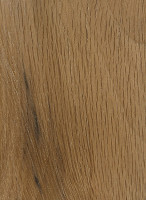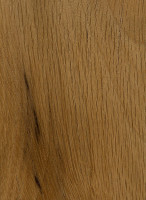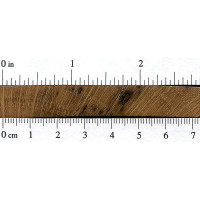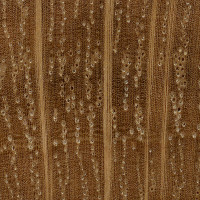 |
Common Name(s): Live Oak, Southern Live Oak
Scientific Name: Quercus virginiana Distribution: Southeastern United States Tree Size: 40-60 ft (12-18 m) tall, 4-6 ft (1.2-1.8 m) trunk diameter Average Dried Weight: 63 lbs/ft3 (1,000 kg/m3) Specific Gravity (Basic, 12% MC): .80, 1.00 Janka Hardness: 2,680 lbf (12,920 N) Modulus of Rupture: 18,220 lbf/in2 (125.6 MPa) Elastic Modulus: 1,960,000 lbf/in2 (13.52 GPa) Crushing Strength: 8,810 lbf/in2 (60.8 MPa) Shrinkage: Radial: 6.6%, Tangential: 9.5%, Volumetric: 14.7%, T/R Ratio: 1.4 |
Color/Appearance: Has a light to medium brown color, though there can be a fair amount of variation in color. Conversely, Red Oak tends to be slightly redder, but is by no means a reliable method of determining the type of Oak.
Grain/Texture: Grain is straight, with a coarse, uneven texture. May have irregular grain depending on growing conditions of the tree.
Endgrain: Diffuse-porous; exclusively solitary; large to very large pores arranged radially, few; tyloses abundant; parenchyma vasicentric, diffuse-in-aggregates; very wide aggregate rays and narrow rays, spacing normal.
Rot Resistance: Live Oak has been rated as having very good resistance to decay, and has been used frequently in ship and boatbuilding.
Workability: Easy to glue, and takes stain and finishes very well. Though, due to its incredible density, (especially for an oak), Live Oak is harder to work with than other species of the Quercus genus.
Odor: Has a tell-tale smell that is common to most oaks. Most find it appealing.
Allergies/Toxicity: Although severe reactions are quite uncommon, oak has been reported as a sensitizer. Usually most common reactions simply include eye and skin irritation, as well as asthma-like symptoms. See the articles Wood Allergies and Toxicity and Wood Dust Safety for more information.
Pricing/Availability: Seldom available commercially, Live Oak may only be available from local sawmills within its native range. Expect prices to be higher than most other domestic species.
Sustainability: This wood species is not listed in the CITES Appendices or on the IUCN Red List of Threatened Species.
Common Uses: Cabinetry, furniture, interior trim, flooring, boatbuilding, barrels, and veneer.
Comments: Live Oak shares many of the same traits as White Oak (Quercus alba), though it is diffuse porous and readily separable from white oaks on the basis of anatomy.
Historically, it has been used in shipbuilding, and was even used in the construction of the USS Constitution, which was fittingly named “Old Ironsides”—an incontrovertible testament to the wood’s toughness.
- Black Oak (Quercus velutina)
- Bog Oak
- Brown Oak
- Bur Oak (Quercus macrocarpa)
- California Black Oak (Quercus kelloggii)
- Cherrybark Oak (Quercus pagoda)
- Chestnut Oak (Quercus prinus)
- English Oak (Quercus robur)
- Holm Oak (Quercus ilex)
- Japanese Oak (Quercus mongolica)
- Laurel Oak (Quercus laurifolia)
- Oregon White Oak (Quercus garryana)
- Overcup Oak (Quercus lyrata)
- Pin Oak (Quercus palustris)
- Post Oak (Quercus stellata)
- Red Oak (Quercus rubra)
- Scarlet Oak (Quercus coccinea)
- Sessile Oak (Quercus petraea)
- Shumard Oak (Quercus shumardii)
- Southern Red Oak (Quercus falcata)
- Swamp Chestnut Oak (Quercus michauxii)
- Swamp White Oak (Quercus bicolor)
- Turkey Oak (Quercus cerris)
- Water Oak (Quercus nigra)
- White Oak (Quercus alba)
- Willow Oak (Quercus phellos)
 |
 |
 |
 |


Hello, does anyone have experience using California coastal live oak wood? IN Santa Barbara county. Had one fall about 4 ft in diameter and about 14 ft if thy at is straight, which is unusual. Thinking about milling it. Can I use it green?
You need to let it dry. Live oak has a tendency to twist terribly. I aged some that was intended for fire wood for 7 years. It’s beautiful now with incredible design. I don’t think you have to wait that long but do oversized cuts that you can cut later to the desired size
Thanks brad, that looks great. Beautiful wood. Yes, since I posted I chatted with two guys who mill local woods. One in Big Sur and another in SB county, both said live oak is terrible to mill and unstable. I was advised to mill to 4 inches, let dry and twist a few years and then re mill and plan to get two inches. I also was told it’s very susceptible to a certain bug we have here. I’m going to pass the wood off to firewood now, but after seeing that grain you have maybe it’s worth saving some… Read more »
Is this southern live oak?
Looks more like Red Oak to me.
Does anyone know if 1 inch saplings are hard/strong enough to make walking canes/ fighting sticks out of? or is it only the adult tree with the high janka rating?
At that size, it would be all sapwood, and in general, sapwood is at least slightly weaker and lighter in weight than heartwood. To what extent, I don’t know. I’m not aware of a study on live oak that evaluates the sapwood, generally strength tests are carried out on heartwood.
thanx
I’ve not used saplings, but I have used smaller diameter (1″-2″) diameter live oak branches off a larger tree for jewelry and coffee scoops. Still very hard and tough on your carving tools – even when it’s green. The biggest issue I’ve run into with live oak is checking/splitting on the ends.
You could always try it and see. Just make sure to leave a few extra inches on both ends to account for the checking.
I don’t know about Live Oak, but i have made 3 Oak walking sticks: Red Oak, White Oak, and Water Oak, all from east TX, all from 3/4″ – 1″ branches. I’ll second what Kevin said. They start out straight as an arrow, but 2-3 momths into drying they warp, and by the time they are done drying, it’s hard to remember that it started out straight. The Red Oak was the worst in that it twisted as it dryed. The 1″ branch turned into a +2″ spiral! All three types also tended to split radially. I finished them with… Read more »
Absolutely beautiful wood, just be prepared to sweat, bleed and cuss when working with it. The parts of Texas and Florida I have lived in called it “American Ironwood” for how hard it is. It also has a way of forming cracks along with the Spaulding in some pieces, meaning just when you think you have sanded it flat, suddenly there is a hole in the middle of the wood. This is likely because I work exclusively with reclaimed and found lumber so the stock I get is from windfalls and tree trimming, but I thought I’d warn you. But… Read more »
Living in Florida Live Oak is very common. I have worked it several times, mostly lathe work. Sharp tools are a must, so keep your grinding wheel close by. If you are patient the grain produces some beautiful results, but it does tend to check. Hand sawing is fruitless, carbide blades are a must. As Keith said, even the best chainsaws will get a workout when cutting logs into workable lumber.
Live oak grows with a sort of ropey/twisted grain. Since the grain doesn’t run straight, wedges don’t work so well. However, the waviness of the grain translates to the surface which ends up looking like an animal pelt. If you’ve ever tried ammonia fuming of white oak, live oak does the same thing but much darker and faster. It is indeed very hard and I was only able to shave off a very small portion at a time on my planer. The ropey texture also means tear out so I highly recommend drum or wide belt sanding to final thickness.… Read more »
I have not worked with as far as wood working goes but I did cut up the secondary trunk of a century live oak ( None to be over one hundred years old) with a 60cc 25in bar stihl chainsaw. The trunk was over 3 feet wide and it was hard as rock. Even with a professional saw like that it was hard to cut. I took a sharpened hatchet and tried to stick it in the end of the tree and it bounced out of my hand without making a dent. I tried several times with the same results.… Read more »
Do you think live oak would hold up for out door structure timber framing in the south west high desert climate?
The problem with live oak is that it is, by nature, a sprawling tree that doesn’t play well with others, as in a forest stand. It grows close to the ocean and prefers coastal grass plains. Therefore, it has a very short trunk and lots of limbs. Long planks of any size are almost unheard of. Short runs could be glued together, but supporting its own weight out of water could be an issue. White pine (if strong enough for your application) treated with Timbor would probably be sufficient for several years, and can be retreated as needed if left… Read more »
The real problem is that it is very difficult to mill and there is no commercial market for live oak. Live oak grows much taller and straighter in more crowded inland forests. You may not recognize it because it does not look unusual there. I’m pretty sure that much of the oak forest near the Aucilla River along Hwy 98 west of Perry, FL is live oak. There is or was only one(?) sawmill, Steve Cross Sawmill, in Iron City, GA, specializing in large live oak timber. The Chesapeake Bay Maritime Museum Bought some from Steve to build a large… Read more »
Certainly, as long as it can handle strain of any draught in the joint.